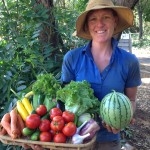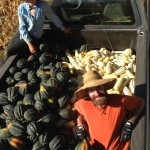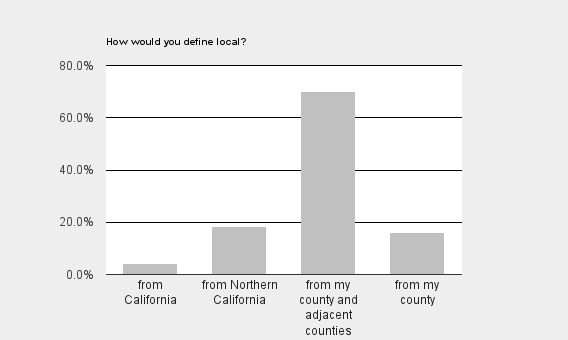- Author: Deena Miller
There is a lull. Somewhere between the storage crops and greens of winter, and the fresh mild arugula and straight green spears of asparagus in the spring, I start to feel like a potato. We have weathered the worst of it, and the produce is coming back with momentum from the valley and warm spring starts in the higher foothills. That also means that those of us who frequent seasonal farmers markets will have them back!
Farmers markets are many things; a social connection, an opportunity to purchase the freshest food available, the chance to access a myriad of local goods in one place, and the rare instance where your dollar goes directly to the people growing your food or making crafts. They also are not as expensive as you may think! Price data the Eat Local team collected last year (January 2014 through July 2014 shows that organic produce is priced similarly at farmers' markets and grocery stores. For 5 of the 10 items measured, farmers' market prices were actually cheaper or equal to that those of grocery stores! For a closer look at these price comparisons, read our archived blog post “Are Farmers' Market Prices Really More Expensive?” (http://ucanr.edu/blogs/blogcore/postdetail.cfm?postnum=15299)
If everyone in Placer/Nevada county went to the farmers market a few times through the year and spent $10, can you imagine the impact?? We could boost our local economy enough to enable our friends and neighbors to make a living wage working in as famers in our community. And that money would stay local! So go, post your experience to Facebook or other social media, bring a friend or meet one there, buy from the markets for pot lucks or BBQs, and don't be shy to brag where you got that amazing watermelon.
Farmland and green, open space is a beautiful and valuable part of living here in the foothills. Help preserve the beauty and bounty of our counties by buying local…. at the Farmers' Market!
Markets open now:
Auburn, Old Town Courthouse Parking Lot, Open Year-round, Saturdays, 8 AM to 12 noon. Auburn-Folsom Road at Lincoln Way. Foothill Farmers' Market Association.
Grass Valley, North Star House, Saturdays, 8 AM to 12:30 PM. 12075 Auburn Road. Nevada County Certified Growers' Market.
Roseville, Whole Foods Market at the Fountains, Open Year-round, Tuesdays, 8:30am – 1pm. Galleria Blvd. & East Roseville Parkway. Foothill Farmers' Market Association.
For more information on seasonal markets opening soon, check out these webpages:
http://www.foothillfarmersmarket.com/
- Author: Jim Muck
One of the fun things we do here at the Eat Local Project is develop recipes that highlight the amazing bounty of fruits and vegetables grown in our region. Over the last two years we have developed over 35 recipes and had them printed on great looking recipe cards. The process we use when we create new recipes is a team effort, and we enlist “Guinea pigs” (office staff) to taste our ideas and provide a thumbs up or thumbs down. In other words, our office mates bring us down to reality and give us helpful feedback to temper our vegetable mania.
We have rules that help us stay on track throughout the throughout the recipe development process. The rules are: not too many ingredients, not too many complicated steps, and finally, the recipe can't take too long to prepare because most people don't want to spend more than 30 minutes cooking after they get home from a long day at work. Of course, different seasons bring different fruits and vegetables, and so we work to have recipes for each season to help people eat locally grown produce all year long. The long period between January and May can get a little tedious in the kitchen. How many ways can you cook kale and still find it fascinating? After taking a stroll through farmers markets in winter, we decided that Leeks would be a good candidate for a new recipe.
Leeks are one of those vegetables that almost everyone knows about, but hardly ever use in the kitchen. Leeks taste like very mild onions, which make them a little difficult to use. The classic leek recipe is vichyssoise: a cold soup of cooked potatoes and leeks. The soup is fabulous, but there are lots of recipes out in the world for vichyssoise, we wanted to create something new. The goal when cooking with leeks is to highlight and build on that mild flavor. The job of the cook is to amplify the “leekiness” while trying to create something that doesn't taste bland and boring.
We don't do boring here at Eat Local, so we needed to find a complement for the leeks other than potatoes, so we went into the kitchen and started experimenting. The first complementary candidate was Swiss chard sautéed with the leeks. The results were not encouraging. The greens were too strong and overwhelmed the flavor of the leeks. So out with the chard and in with carrots. We tried carrots and leeks cooked together with lots of olive oil, using a Turkish method of long stewing. This recipe, though delicious, got the boot too: the carrots were too mushy, the amount of olive oil was excessive, and the cooking time way too long for most busy people to attempt on a week night. The next candidate was mushrooms. The mushrooms were a hit and there are lots of mushrooms available at the farmers markets at the same time there are lots of leeks available. Ta da! Chalk up another one for the record books we have a recipe. Uh, hold on a tick: the chatter around the office campfire is that the flavor needs a little help. The recipe is too mild and boring. Like I said before we don't “do” boring at Eat Local so it was time to punch up the flavor, but not make the leeks disappear. A little rosemary and some lemon juice did the trick and now we had a recipe that was ready to get printed.
Carol, our graphic designer, works magic and manages to get all of the ingredients and preparation steps onto the card, while at the same time making the cards look beautiful. With the design done and the cards printed, we debuted the recipe at the Auburn farmers market on a beautiful Saturday morning. The crowd loved the recipe and the farmers sold out of leeks.
We have lots of recipe cards available for both farmers and consumers at the UCCE Cooperative Extension office in Auburn. Consumers can just drop buy the office and grab some recipe cards from the racks located in the lobby. Farmers: if you would like to enough cards to hand out to your customers, send an email to jimmuck@ucdavis.edu. The recipe is also posted to our website http://ucanr.edu/sites/EatLocalPlacerNevada/, so take a look, get some leeks, and start cooking!

- Author: Deena Miller
What is something you are enjoying eating from your farm right now?
We are still eating our potatoes from the 2014 crop, and we love potatoes! What is especially exciting is that we are getting the first of the goat's milk for the season. We are also eating some greens, mainly dino kale and some foraged greens like miner's lettuce and chickweed from around the farm.
Are you growing or raising anything new in 2015?
We are excited about growing nettles this year. Two years ago we dug up some nettles from Misty Meadows and put them in a wet zone by our water cistern. Last year we put in a larger patch for ourselves and thought that they could be a great medicinal food to bring to market. Also, we heard from Shana Maziarz at Three Forks that when they have nettle pizza they sell out every time. Hopefully we will be able to get multiple harvests since it will be irrigated, it is good to use just as long as you harvest before it flowers and set seeds.
[So should people be watching out for nettles it at market?]
I hope so!
Besides trailing the nettles, we will be growing cauliflower and broccoli in the fall, which is really exciting. Another new venture will be growing in the greenhouses through the summer, a few varieties of tomatoes and peppers. Since we are a cooler site it hasn't made sense in the past to grow peppers and heirloom tomatoes, so we have just stuck with cherry tomatoes until now. I am also growing some new herbs which you may see in the market!
What crops or tools are you leaving behind in 2014?
There are some herbs I am taking out, certain items that I have sold in the past that don't sell large enough quantities to warrant full beds. I'm excited to be planting more commonly used herbs for the farmers market and planting more flowers for the bees in the fall. We may be growing our bees in the future.
What is your favorite tool?
My personal favorite tool is one very specific digging fork. I won't even let Tim use it for fear he could break it. It goes everywhere with me at certain times of the year!
Tim Van Wagner and Ashely Votaw of First Rain Farm produce vegetables, herbs, seeds and goat milk in Nevada City, Ca. You can find out more about First Rain Farm and where to find their products at http://www.firstrainfarm.com

- Author: Deena Miller
What is something you are enjoying eating from your farm right now?
We have a bunch of spinach right now, and its super sweet from the cold. I usually eat it with every meal of the day; scrambled with eggs for breakfast, a large spinach salad with grains for lunch, or in a sauté for dinner.
Are you growing or raising anything new in 2015?
Yes! A few fun crops like peanuts, Jerusalem artichokes and also some loofa. As far as standard crops go, we are trying some new lettuces and some new heirloom tomatoes.
What crops or tools are you leaving behind in 2014?
Thelma Sanders winter squash, and we are growing a little less fennel. We have only really added things! We are leaving behind micro sprinklers for irrigation in favor of drip tape.
What is your favorite tool?
We want to use our cultivating tractor more this coming year, which is my favorite large tool. My favorite hand tool is the hula hoe.
Foothill Roots Farm is run by Patrick and Diane Bollinger located on the beautiful Simpson Ranch in Meadow Vista California. They grow a diverse assortment of vegetables for their CSA (Community Supported Agriculture) program, wholesale and retail outlets, local restaurants, and farm stand. Their 2015 Summer CSA sign ups are now open at http://foothillrootsfarm.com/



- Author: Molly Nakahara
Here at the Eat Local Placer Nevada Project, we want you to eat more locally grown fruits, vegetables and nuts! In order to achieve our goal, we decided to survey consumers in Placer and Nevada counties to learn more about how, when, where and why folks purchase locally grown produce. The results are in and we've got some really interesting information to share with you.
In Placer and Nevada counties, our definition of “local” is far stricter than what is recognized as a “local” product. In 2008, the U.S. Congress adopted the Food, Conservation and Energy Act which considered the boundary for a “locally or regionally produced agricultural food product” as 400 miles or within its State of origin. Almost 70% of participants of the Eat Local Placer and Nevada survey defined “local” as “from my county and adjacent counties.” This is great news for our local farm economy; consumers looking for locally grown produce are truly looking to the farms and farmers' markets in their neighborhoods.
76.2% of participants reported buying locally grown fruits and vegetables on a weekly basis and 66.7% chose farmers' markets as the main place of purchase. Put together, this information says much about the regional culture of buying locally grown produce. For many, it appears that buying local is not just about procuring food for the dinner table, but rather a social component of their lives. As many of you know, the farmers' market is a great outing to share with friends and family.
When asked what the primary reason for buying locally grown fruits and vegetables, three answers were selected evenly: to support local farmers, personal and/or environmental health, and taste/quality. My hope is that this diversity of answers shows a robust and resilient consumer base that currently supports our local growers. As a farmer myself, I am gladdened by the number of participants that chose supporting local farmers as their main motivation for buying local. The farmers' market is a highlight of my week. I am always re-energized by my interactions with customers and reminded of why I love to grow food for my community.
In response to the barriers to purchasing more local food, 46.2% of survey participants chose cost as the most prohibitive factor. The truth of agriculture in the foothills is that production costs are higher than other areas of the state. Limited access to arable land and skilled labor are two of the challenges we frequently hear about from farmers and two factors that certainly increase production costs. When we look at this response along with the reasons for buying locally grown, the picture becomes more focused. Consumers are buying local for a whole bunch of other reasons than to save money including health, environmental awareness, and support for the local agriculture community. Cost as the primary barrier to purchasing local food appears rather to be a statement: we would buy more if we could.
Thank you to everyone who took the time to respond to our survey. We look forward to learning and sharing more about local fruit, vegetable and tree nut production and consumption!



